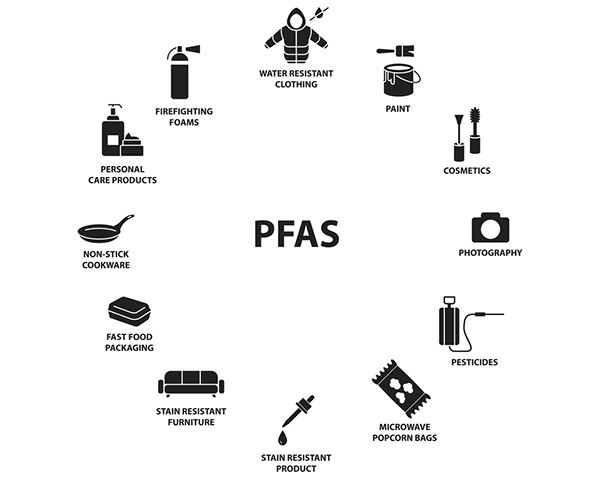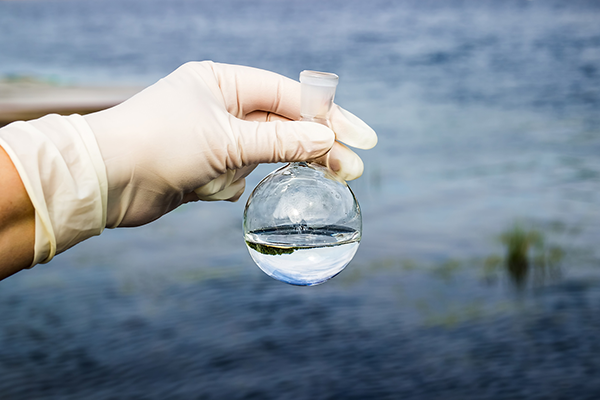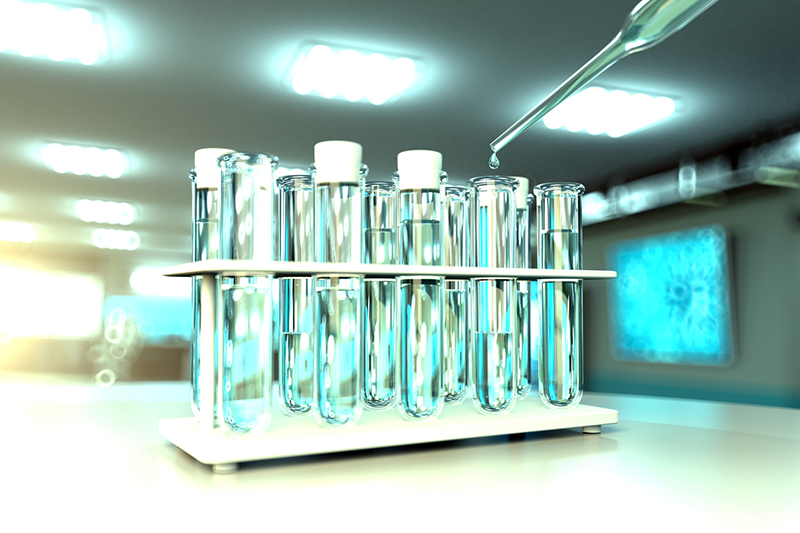
by manovermachine | Dec 16, 2022 | Camp Lejeune Contaminated Water
States step up to combat PFAS
Nearly all Americans are exposed to water tainted with low levels of toxic chemicals. The Legal Examiner recently stated that 97% of the US population has these chemicals in their bloodstream. Perfluoroalkyl and polyfluoroalkyl substances (PFAS) are also called “forever chemicals” because they don’t break down in the environment.
PFAS have been present in drinking water since the 1940s and a recent study found that the contamination of soil, rain, and surface water is so pervasive that it cannot be reversed without advanced or expensive technology. More than 2,800 sites in all 50 states are contaminated by PFAS.
What Are PFAS Used For?
PFAS are used for nonstick pans, waterproofing outdoor clothing, food packaging, carpeting, and firefighting foam used on military bases and commercial airports. They are also found in waterproof cosmetics, sunscreen, shampoo, and shaving cream. Waxes, paints, and stains also contain PFAS. They are literally present in abundance in everyday life.
What Are the Health Risks From PFAS?
Research has linked PFAS to a host of health problems. Kidney cancer, testicular cancer, endocrine disruption and even an increased risk of contracting infectious diseases like COVID-19 as well as reducing the effectiveness of vaccines.
The toxic contamination of water at more than 400 active and closed military bases has drawn a lot of attention due to the devastating illnesses and adverse health effects. The most infamous case involves North Carolina’s Camp Lejeune. Documented illnesses there include birth defects, infertility, miscarriages, live and kidney disorders, autoimmune diseases, cardiovascular diseases, Parkinson’s disease, Non-Hodgkin’s lymphoma, and at least nine different cancers.
What About Federal Regulation of PFAS?
When the Toxic Substances Control Act of 1976 was enacted, PFAS were not included. The Clean Water Act and the Clean Air Act of the 1970s also didn’t include PFAS. The companies who originally created them were supposed to research the potential harms of these chemicals and inform the Environmental Protection Agency (EPA) of the results. They kept the results of their research secret for decades.
The 1980 Superfund Law created a tax on petroleum and chemical industries and billions of dollars were used to clean up abandoned hazardous waste sites, but thousands of sites were not included.
In August of 2022, the EPA proposed that two commonly used PFAS should be classified as hazardous substances and there should be advisories on their presence in drinking water. If implemented, these advisories are not laws, and therefore wouldn’t carry the force of law.
What Are the States Doing About PFAS?
Rather than wait for the EPA and federal regulations to take action, many states are stepping up. They are enforcing drinking water standards, adopting PFAS guidance and notification actions, replacing PFAS in certain products with safer alternatives, and more.
- Maine and Washington state agencies have the authority to ban PFAS in many products
- Eleven states have begun removing PFAS from food packaging
- Five states are restricting PFAS in carpets, rugs and more
- California, Colorado and Maryland are eliminating PFAS from cosmetics
- Eleven states have banned the sale of firefighting foam with PFAS
- Maine became the first state to ban PFAS in all new products except those essential to health and safety that doesn’t have a PFAS-free alternative
Sixteen states have filed lawsuits against PFAS manufacturers like the 2018 lawsuit by the state of Minnesota against 3M that resulted in a settlement of $850 million. Industry advocates oppose a federal ban on PFAS and while there is ongoing disagreement among legislators on what federal regulations should be, states are taking independent action.

by manovermachine | Oct 18, 2022 | Camp Lejeune Contaminated Water
The DisabledVeterans.org blog reminds veterans about possible benefits offset
The Honoring our Promise to Address Comprehensive Toxics Act of 2022 (PACT Act) that the Biden administration signed into law in August 2022 does include the Camp Lejeune Justice Act. This act made it possible for veterans and affected civilians to receive compensation for injuries due to exposure to the contaminated water at Camp Lejeune between August 1, 1953 and December 31, 1987.
Prior to the PACT Act, the Federal Tort Claims Act and 38 USC § 1151 established that veterans cannot collect twice for the same injury. Therefore it is possible that an offset to compensation through the VA, Medicare, or Medicaid will apply if the medical malpractice claims against the Department of Veteran Affairs is successful. This is also true for civilians.
It’s not clear how the safeguards against “double dipping” will be applied, but the PACT Act states:
2) Health and disability benefits relating to water exposure–Any award made to an individual, or legal representative of an individual, under this section shall be offset by the amount of any disability award, payment, or benefit provided to the individual, or legal representative–
(A) under–
(i) any program under the laws administered by the Secretary of Veterans Affairs;
(ii) the Medicare program under title XVIII of the Social Security Act (42 U.S.C. 1395 et seq.); or
(iii) the Medicaid program under title XIX of the Social Security Act (42 U.S.C. 1396 et seq.); and
(B) in connection with health care or a disability relating to exposure to the water at Camp Lejeune.
PACT Act § 804(e)(2).
It’s possible that the offset provision in the PACT Act will incorporate benefits and health care already paid plus future projected benefits and health care services. If a veteran is awarded compensation through litigation, the possible PACT Act offset would not apply to any awards for pain and suffering and loss of income. However, until clear guidance comes from the VA and Social Security on how they plan to implement the offset, it’s speculation at this point.

by manovermachine | Aug 18, 2022 | Camp Lejeune Contaminated Water
Chemical pollution of the drinking water at Camp Lejeune, North Carolina has been the subject of many studies and the target of many lawsuits from U.S. veterans, their family members, contractors, and others who were present at the base between 1953 and 1987.
How the Water Got Polluted
Volatile organic compounds (VOCs) were found in the drinking water provided by three of the eight water treatment plants at Camp Lejeune. The water from the Tarawa Terrace water treatment plant was primarily contaminated by an off-base dry cleaning company and their waste disposal practices. Perchloroethylene (PCE) or tetrachloroethylene from the dry cleaner contaminated the wells feeding that water treatment plant.
The Hadnot Point water treatment plant was contaminated primarily by trichloroethylene (TCE) but PCE, benzene, TCE degradation products, and vinyl chloride were also found in the water. The contamination came from multiple sources, including leaking underground storage tanks, industrial area spills, and waste disposal sites.
Areas served by the Holcomb Boulevard water treatment plant were intermittently supplemented by contaminated water from the Hadnot Point plant during high demand spring and summer months from 1972-1985. Holcomb Boulevard wells were generally not contaminated.
Water for drinking, cooking, bathing, laundry, gardening and other daily activities was found to have hazardous levels of chemical contamination for a period of 34 years total, affected hundreds of thousands of people.
How the Contaminated Water Affected Those Who Were Exposed
The chemicals that contaminated the water at Camp Lejeune for so many years are known human carcinogens. It is likely that increased risk of various cancers, birth disorders, fetal and infant death, and other illnesses resulted.
The CDC has stated that sufficient evidence for causation of certain health effects exists for the chemicals detected in the drinking water at Camp Lejeune as follows:
- TCE has been shown to cause kidney cancer, non-Hodgkin’s lymphoma, and various cardiac defects
- PCE has been shown to cause bladder cancer
- Benzene has been shown to cause leukemias and non-Hodgkin’s lymphoma
- Vinyl chloride has been shown to cause liver cancer
The CDC has also concluded that exposure to the drinking water at Camp Lejeune cannot definitively be said to cause the following illnesses, but there is enough evidence to support a link between the exposure and the health effects. This means the evidence is “equipoise and above”.
- TCE is equipoise and above for leukemia, liver cancer, multiple myeloma, end-stage renal disease, Parkinson’s disease, and scleroderma.
- PCE is equipoise and above for non-Hodgkin’s lymphoma and end-stage renal disease
- Benzene is equipoise and above for multiple myeloma
TCE and PCE have been shown to have health effects in populations other than Camp Lejeune for the following:
- Chonal atresia (nasal passages blocked with bone or tissue)
- Eye defects
- Low birth weight
- Fetal death
- Major malformations
- Miscarriage
- Neural tube defects
- Oral cleft defects (including cleft lip)
- Small for gestational age
- Breast cancer
- Cervical cancer
- Esophageal cancer
- Lung cancer
- Hodgkins disease
- Ovarian cancer
- Prostate cancer
- Rectal cancer
- Impaired immune system function
- Neurological effects (delayed reaction times problems with short-term memory, visual perception, attention, and color vision)
- Neurobehavioral performance deficits (i.e., delayed recall and deficits in visual perception), decreased blink reflex, and mood effects (i.e., confusion, depression and tension)
- Severe, generalized hypersensitivity skin disorder (an autoimmune-related disease
Benzene has been shown to have health effects in populations other than Camp Lejeune for the following:
- Aplastic anemia
- Myelodysplastic syndromes
- Miscarriage
Vinyl chloride has been shown to have health effects in populations other than Camp Lejeune for the following:
- Brain cancer
- Lung cancer
- Soft tissue cancer
- Liver cirrhosis
Since March of 1987 Camp Lejeune’s drinking water has been considered safe. It is in compliance with comprehensive federal and state laws and regulations. The water is checked for VOCs more frequently than required by law and the base issues annual Consumer Confidence Reports to all residents of the base on the quality of their water.


